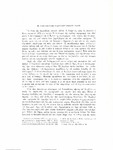| dc.description.abstract | The clearing of the inner face of the West Cyclopean Wall revealed again
the foundation existing below the retaining wall of the parapet of slabs of Grave
Circle A (PI. 23). Its complete clearance proved that it is a segment of a circular
wall that originally limited the area of the shaft graves. The investigation of
its fill, under the supervision of Miss Olga Alexandri, yielded 22 small sherds
dating the wall. Of these 4 were Gray Minyan, 11 Yellow Minyan, 7 mattpainted,
one with a geometric decoration painted in dull white color. These sherds
prove that the circular wall is contemporary with the earlier shaft graves of Circle
A and place it to the second half and towards the end of the MH period.
The clearance, by the late Dr. John Papadimitriou, of a cist grave under
the slabs of the parapet some 1.30 m. from the entrance of the Circle enabled
him to point out that at places the foundation stones of the Ramp rest over
a layer of chips formed when the slabs of the parapet were worked and to conclude
that the Ramp was not contemporary with the rearrangement of the Circle
as maintained by Wace. The further investigation of the area confirmed that observation
(Figs. 68 and 69) and proved that the stones of that foundation in
places overlap the base of the broken slabs (Figs. 71, 72, and 73). This proves
definitely that the retaining wall of the Ramp was built sometime after the rearrangement
of the Circle. The examination of the interstices of the block of that
wall (Fig. 74) failed to yield sherds that would determine its date, but brought to light a drain which had remained undetected (Figs. 75, 76, and 77). Its opening
was found closed with small stones and this seems to have occurred at the
beginning of LH III C, as the latest sherds found in its fill indicate (Figs. 73,
78, and 79). The drain and its relation to the area immediately to the west of
the Grave Circle — to the Little Ramp, the Ramp House, etc.— remain problematical
and will be investigated at a later date.
The effort to determine the date of the Great Ramp culminated in a trench
some 5.50 m. in length from north to south and 3.45 m. in width from east to
west. The present-day cobblestone pavement was considered as Stratum No. 1.
Below it a layer of earth containing some small stones was found, Stratum 2,
averaging 45-50 cm. in depth; it yielded 54 sherds, 4 of which were painted
(Fig. 80, Nos. 6- 14). Stratum 3 was composed of a fill of Cyclopean blocks
in three superposed rows (Figs. 81, 82, and PI. 24, Γ) loosely piled. The earth
between the stones yielded 42 sherds, 14 of which were painted (Fig. 84 Nos.
11 - 25). Incidentally, on this fill of stones were based the blocks which form
the lateral wall of the Ramp (Fig. 83, ji - π). The conglomerate blocks ««», of the
same figure, form but a single row and not another wall as was assumed heretofore,
meant to retain the fill to the rocky formation beyond. Below the fill of
stones, Stratum 4 was formed of a well - packed layer of earth 10-15 cm. in
depth, evidently the surface of an earlier ramp that ascended from north to south
(Fig. 81 and PL 74); this ramp had an average width of 2.50 m., leaving a free
passage to Grave Circle A of ca. 3.50 m. 18 sherds were found in Stratum 4,
of which 5 were painted (Fig. 84, Nos. 6 - 10). Stratum 5 consisted of another
hard - surfaced layer, 5-17 cm. in depth, made up of hard reddish earth and
pebbles (Fig. 81 and PI. 24). Bvidently it was another ramp which, however, ascended
from south to north. It yielded 5 MH and 20 Mycenaean sherds, of which
9 were painted (Fig. 80, Nos. 15-23). Stratum 6 also contained a hard - surfaced
ramp ascending from south to north laid over a packing of stones (Fig. 81 and
PI. 24). All the sherds from this stratum belong to the MH period. The lowermost
Stratum (No. 7) below the fill of stones of Stratum 6, extended to the rock,
was made up of brownish earth, and contained MH sherds; its lowermost 10 cm.
yielded also some BH plain sherds.
It is . evident from the description of the layers that we have 4 different,
superimposed ramps. Ramp No 1 is the existing cobble - covered Ramp that apparently
was made towards the end of LH III B. Ramp 2 of Stratum 4 an earlier
construction, belongs to the middle of LH III B and evidently was constructed
when the Lion Gate was built. Ramp 3, in Stratum 5, with a different
direction of ascent (from south to north), also belongs to LH III times, but it
preceded the construction of the Lion Gate and led to the entrance of the first
citadel (Fig. 85). Ramp 4, in Stratum 6, was the original ascent to the northwest
slope and through it to the top of the hill used from MH to LH III A times. Ramp No i covered completely the area to the Grave Circle and thus blocked
the passage to the houses and buildings to the west of that Circle. To make
access possible the Little Ramp was then built, which thus is indicated to be
contemporary with Ramp i, and should be placed towards the end of LH III B. | en |



